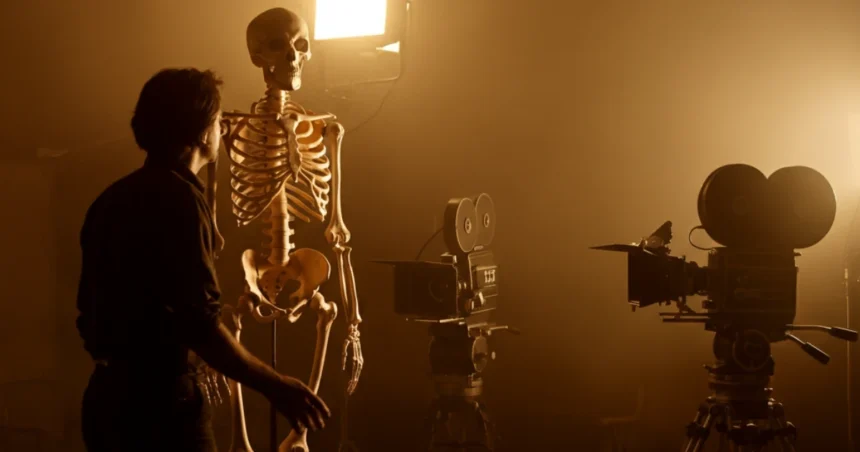When it debuted in 1982, Poltergeist terrified audiences with its chilling storyline and frightening visuals, cementing its place as one of the most iconic horror movies of all time. Directed by Tobe Hooper and co-written and produced by Steven Spielberg, the supernatural thriller captured imaginations worldwide. However, over the years, Poltergeist became infamous for more than just its on-screen scares. A long-standing claim that real human skeletons were used in certain scenes has added an unnerving layer to the film’s legend.
How much truth is there to this claim? Let’s examine the evidence, the historical and ethical context, and the lasting impact of this unsettling detail on the film’s legacy.
The Claim: Did Poltergeist Really Use Real Skeletons?
One of the most infamous urban legends surrounding Poltergeist is that real human skeletons were used during the now-iconic swimming pool scene. This sequence features Diane Freeling (JoBeth Williams) tumbling into a pool filled with dirt, mud, and what appear to be skeletons clawing their way toward her.
The idea of real human remains being used in a major motion picture is both shocking and macabre. However, many reports and firsthand sources suggest this claim is more than just an urban myth.
Historical Context: Props and Special Effects in 1982
To understand why the use of real skeletons was even plausible, it helps to consider filmmaking practices in the early 1980s. During this period, Hollywood often relied on practical effects and physical props rather than CGI. Creating lifelike props involved skilled craftsmanship, but budget constraints were always a concern.
At the time, fabricated skeletons made of materials like latex or resin were an option, but they could be expensive and time-consuming to produce. On the other hand, real skeletons were surprisingly accessible and affordable, often used for educational purposes or in medical research. Procurement of these skeletons, especially from international sources, was not heavily regulated.
Evidence Supporting the Claim
Interviews and behind-the-scenes accounts strongly support the unsettling possibility that real skeletons were indeed used in Poltergeist. JoBeth Williams, who played Diane Freeling, has openly stated in interviews that the skeletons in the pool scene were real. During a 2002 appearance on VH1’s I Love the ‘80s, Williams claimed:
“You have to understand that this was a low-budget movie. They came from a medical supply company, and I assumed they were fake. I found out later that they were, in fact, real skeletons. I think the reason they used real skeletons is because it’s far too expensive to make fake ones.”
Special effects artist Craig Reardon, who worked on the film, also confirmed that actual skeletons were used in various scenes, describing it as a common industry practice back then. According to Reardon, it was cheaper to purchase skeletons for medical use than to have artificial ones custom-made.
Why Use Real Skeletons?
One of the primary reasons real skeletons might have been used in Poltergeist boils down to cost. Custom-made fake skeletons of high quality could significantly strain a production’s budget. For a film with practical effects at its core, cutting costs in areas like prop creation may have been seen as reasonable at the time.
Additionally, real skeletons often appeared more authentic on camera. Prosthetics and replicas from earlier decades sometimes failed to mimic the natural structure and intricate details of human bones. By using real skeletons, filmmakers could achieve a higher level of realism, which was especially important for a movie that sought to immerse viewers in its terrifying world.
Ethical Considerations of Using Real Skeletons
The decision to use real human remains raises serious ethical concerns. While obtaining skeletons for educational or research purposes was standard, repurposing them as props in a horror movie presents a moral dilemma. Skeletons sourced from medical suppliers were likely unclaimed remains, yet their use in entertainment rather than a dignified setting blurs ethical lines.
Critics of this practice question the lack of consent from the individuals whose bodies were repurposed. Even if these skeletons were sold legally, should they have been used for such a purpose? These concerns are especially pertinent from today’s perspective, where greater consideration is given to ethics in filmmaking.
Reactions from Cast and Crew
The realization that real skeletons were used shocked not only viewers but also some members of the Poltergeist cast. JoBeth Williams admitted that she was unaware of their authenticity during filming and only learned about it afterward. This revelation heightened the already eerie atmosphere surrounding the production, especially given the so-called Poltergeist curse linked to the unexpected deaths of several cast members in the years following the film’s release.
While the filmmakers likely didn’t intend to cause harm, the revelation fueled debates about what lengths are acceptable for art and authenticity in cinema.
The Impact on Poltergeist’s Legacy
The claim that real skeletons were used has become an inseparable part of the Poltergeist legacy. For fans, it adds a layer of horror to an already disturbing film, blurring the line between fiction and reality. This revelation has also sparked ongoing discussions about ethical practices in Hollywood and prompted more stringent standards regarding props and on-set materials.
For better or worse, the tale of Poltergeist’s skeletons has cemented its status as a landmark in horror film history—not merely for its scares, but for the conversations it continues to inspire.
Reflecting on Poltergeist’s Haunted History
The use of real skeletons in Poltergeist is a chilling detail that underscores the lengths filmmakers went to create an authentic, unforgettable horror experience. While shocking by today’s standards, it serves as a fascinating case study in Hollywood history, shedding light on how industry practices and ethical considerations have evolved over time.
For fans of the film, this revelation may deepen their appreciation for its eerie atmosphere, but it also prompts a broader question for filmmakers everywhere: How far is too far in the pursuit of realism?






